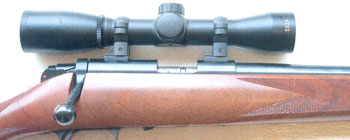
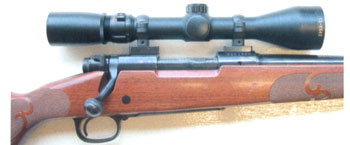
 |
 |
Winchester model 70 .243 with Lynx
2-piece bases and low rings. Scope is a Lynx 1.5-6x42 Professional Series. |
Lynx rimfire claw mounts on a Kimber
82 .22 LR with 4x32 Lynx scope. |
With more than 300 models, Lynx claim to have the "largest
range of scope mounts in the world".
They have windage on both rings, hi-tensile hex clamping screws, lifetime guarantee,
and pre-fitted locking studs for fast and easy fitting, and are machined from
steel bar.
These new Lynx mounts are now being made in the USA by B-square.
The main line of Lynx mounts consist of one and two-piece bases which screw
to the rifle action top via screw holes provided by the factory. This is where
the similarity to other scope mounts ceases. Both rings attach to a pre-fitted
stud using a socket headed tapered point grub screw in both sides of the bottom
of each ring which gives them the unique advantage of having windage in both
rings. While on the dual windage, this is the only place where caution must
be taken when fitting a scope to these mounts. If you make the mistake of tightening
up the front ring windage screws too much before bore sighting, when you adjust
the rear ring, some scope twisting may result because the front ring cannot
move. I have seen this happen with the older Tetra made scope mounts. No permanent
damage resulted, but the scope was reluctant to perform properly. This is covered
in the instructions that come with the mounts, but not made quite clear enough.
The reason, this needs clarifying, is because of the excellence in design of
the locking system, where a male and female taper is used to clamp the ring
to the base.
The clamping force afforded by these tapers is far greater than any other scope
mount system I have used. Because of this extreme clamping force, you need to
be mindful of having the front rings slightly loose when adjusting windage.
Rings available are 1" low, medium and high, and 30mm low, medium and high.
Most rings are available in gloss or matte blued finish. The mounts we received
were matte finish, and in the Lynx Catalogue all stud ring sets and other ring
mounts for. 225, air guns, Weaver-style ring mounts and ring mounts for CZ527,
Tikka and Brno Model 1 and early Model 2, at this stage are all matte finish.
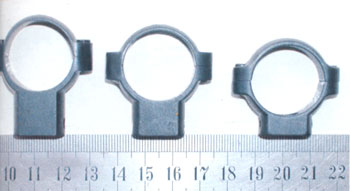 |
High, medium and low
ring heights for a 1" scope. |
Some of the other mounts that Lynx have available are designed for standard dovetailed .22 rifles and air guns, with dovetails ranging from 9.5mm - 11mm and 3/8". These are available in two styles, regular ring mount, and deluxe ring mount. Both are well made from steel, the only difference being in the movable claw which grips the dovetail to attach the mounts to the action. The regular mounts claw is a precision pressed steel claw with an offset hole for the retaining screw. The claw can be reversed, but when it is wrong, the retaining screw can't be screwed in all the way to bring the claw up tight with the bottom corresponding parts of the ring. The deluxe ring mount has a precision machined claw with a corresponding machined slot to ensure parallel travel and correct alignment with the dovetail on the action. For my money, the extra dollars are well spent on the deluxe set.
 |
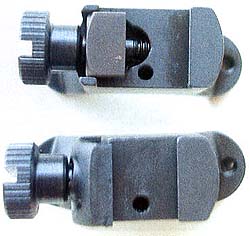 |
Sako bases showing
studs. |
Claws on ring mounts. |
The ring mounts all come with a recoil pin. This is an extra, which if your rifle has a machined slot for this pin, is an added bonus for superior grip to stop any tendency for the mount to slide along the dovetail under recoil, or an accidental knock.
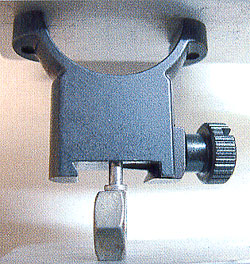 |
Recoil pin - showing how to push
the pin in the base of the ringmount. Note that these pins are press fit
and once fitted are almost impossible to remove without drilling them
out. |
CZ owners will be pleased to see the new line of ring mounts
designed for 16mm, 5/855 dovetail for CZ527 (Fox), Tikka rifles and also the
Bmo Model 1 and early Model 25, as well as ZKW 465 Hornets. These ring mounts
also come with a recoil pin.
The recoil pin is designed to be a press fit, and they need quite a stout hit
with a punch, or press in a vice, using a small hexagon nut on the head of the
pin to ensure it is pressed all the way home. A tip - get some aluminium angle
from your local building shop and make up two pieces for the jaws of your vice
so you don't mark the mounts (see photo opposite, bottom right).
Last but not least in the Lynx range is the "Professional W'' (Weaver-style)
ring mounts. These are designed to mount on a Weaver rail and come in low, medium
or high.
How do they work? I have had this "stud" system style of mount on
an old 98 Mauser in 7x57 for years and they have proved to be 100% reliable.
I also mounted 2-piece stud bases on a Winchester Model 70 in .243 Win, and
a Sako 75 in .223. The Winchester mounts were fine, but I ran into a bit of
a snag with the Sako bases. The front base wouldn't go on the front action ring
far enough, which meant the rings ended up being quite close together. They
would work okay, but experience has shown that the rings need to be as far apart
as possible to afford maximum scope tube support. To be fair, these bases were
made for use on 461, 579, and 61R Sako models. I tried the front base on an
old 461 action, and it didn't go on the dovetail any further than on the 75.
In my opinion, this problem could be overcome by Lynx if they placed a stud
on the front base and on the back of the back base. Also, the dovetail could
be wider to allow it to slide on further. This would address the situation completely.
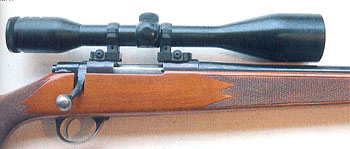 |
Sako L461 with Lynx 2-piece bases
and Meopta scope. Lynx mounts work on any brand of scope. Ideally, author
would prefer rings to be further apart. |
The only other criticism that I have of the Lynx system is the
fact that the low rings are still too high for the optimum mounting of a hunting
scope on the rifles on which I have used them. The positive side of this is
that if you need a 56mm objective scope, this system is more able than most
mount systems to reliably hold your scope in place, thanks to the enormous clamping
pressure afforded by the stud and tapered point high tensile screws which clamp
the ring to the base.
The ring mounts are a quantum leap for for. 22 timbre rifles, when compared
to some of the alloy mounts that have been available. I have been using these
on a CZ527 in. 223. The low version is definitely my pick and they allow the
40mm objective plenty of barrel clearance, however, the bolt handle needs work
for the low mounts to be used (see 6mm PPC article in GUNS&GAME, issue 34).
This thick bolt handle is a CZ glitch, not Lynx.
In conclusion, the Lynx line of scope mounts are some of the most reliable mounts
I've seen, and providing you don't want a scope mounted super low, they are
worth considering as they are very strong, competitively priced and well finished.
Text and photography by Andy Montgomery- GUNS & GAME - April-June, 2003